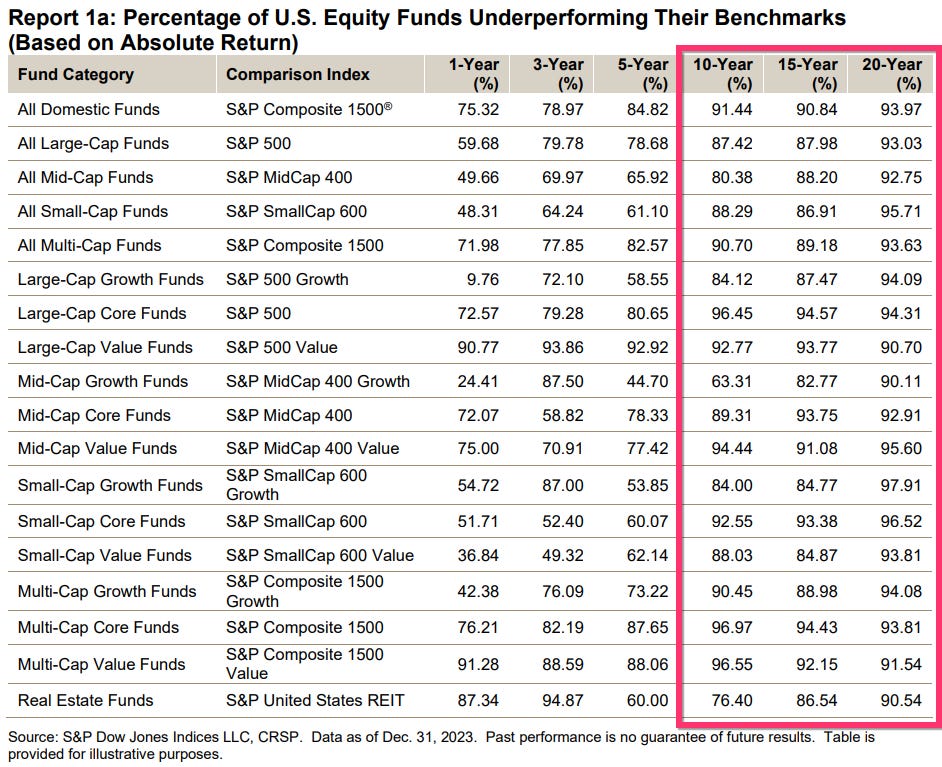
Good morning!
As I type this, it’s a rainy Thursday afternoon in Atlanta.
Helene is dumping rain as she moves through, and we have a lot more rain and high winds to look forward to over the next 18 hours or so.
If you’re in Atlanta or along the storm’s path, I hope you and your family are safe and sound.
And my gratitude 🙏 to each and every one of you who called or messaged to ask how we did with the storm. We’re all good, thankfully.
This recent weather reminds me of this June, 2023, essay I wrote:
Back to today’s topic…
I recently learned something new and quite surprising about individual stock returns.
And it’s relevant to your investment strategy and portfolio decisions.
Note: I’m talking about long-term, strategic, diversified investing here. Not trading or other forms or speculation or gambling, which I advise against at all times.
First, please read this article by Rubin Miller on his Fortunes & Frictions blog, where I discovered this new research:
In fact, read it a second or third time if necessary. Maybe even bookmark it for future reference.
Yes, I believe it’s THAT important to read and understand.
In a little over 800 words, Mr. Miller covers several critical aspects of successful long-term investing.
And life.
They include:
Market Averages: The long-term average return of the stock market is around 8-10% per year. However, this average is driven by a very small number of high-performing stocks, not the performance of most stocks.
Most Individual Stocks Lose: The most common outcome (mode) for individual stocks is a -100% return, meaning investors lose all their money on most stocks.
Skewness in Returns: A few extraordinary stocks, like Nvidia, Apple, or Amazon, generate extreme returns that skew the overall average upward. This explains why the average stock market return is positive despite most individual stocks underperforming.
Portfolio Strategy: Since it's impossible to predict which stocks will be the next big winners, the best strategy is to "buy the haystack" — invest in a broad market index that includes all stocks, ensuring some exposure to future outperformers.
Life Lessons: Just as in investing, where a few stocks drive returns, in life, a few standout events (e.g., weddings, funerals) define our memories. Improving everyday experiences (the mode) can lead to better long-term life satisfaction.
Did you catch that part about most individual stocks going to zero?
Interesting, isn’t it?
I’ve always believed in the referenced “buy the haystack” approach to investing, and shared this John Bogle quote way back in 2008:
While the above article is fresh in your mind, here’s more to chew on:

While there are a lot of numbers in the chart above, here’s the punchline:
The vast majority of professional money managers fail to outperform the market over 10, 15, or 20 years.
And since you’re investing - not speculating - for 10, 15, or 20+ years, this is an important realization.
But get this…
Most professional money managers - along with many amateur consumers - attempt to gain a performance advantage with individual stocks.
But as we’ve seen above - and the research supports - that can be troublesome at best. And ruinous in some situations.
To add insult to injury, the same professional money managers who are attempting to outperform the market (and not doing a very good job of it, based on historical evidence) charge above average fees for what turns out to be below average performance.
Plus they introduce “underperformance risk” as part of the bargain. Something that doesn’t exist with “buy the haystack” total market investing.
And their performance-chasing often creates additional tax liabilities which further eat into their below-average returns.
In tennis terms, these “stock pickers” - professional and consumers alike - are trying to hit winners but instead make a lot of unforced errors, as I’ve written about before:
Thankfully, the solution is simple, inexpensive, tax efficient, and aligns nicely with your financial plan.
It’s the long-term investing approach I personally use and recommend to each and every one of my clients.
And it doesn’t involve individual stocks.
Just buy the entire haystack, and you can stop searching for needles.
This means long-term, total market investing using low-cost, broadly diversified, and tax efficient index funds and ETFs.
You simply don’t need anything else in your investment portfolio.
Surprised by any of the conclusions above?
Questions?
Let me know…
Links & Things
Here’s an interesting article you should check out:
While there are certainly some potential quality of life applications to these ideas, I believe it also pairs nicely with the information above about investing.
Time is such an critical factor in your financial planning, that any fresh concepts or perspectives are well worth our consideration.
Any additional thoughts? Suggestions? Feedback?
Hit reply or leave a comment and share what’s on your mind…
Until next Wednesday,
Russ




